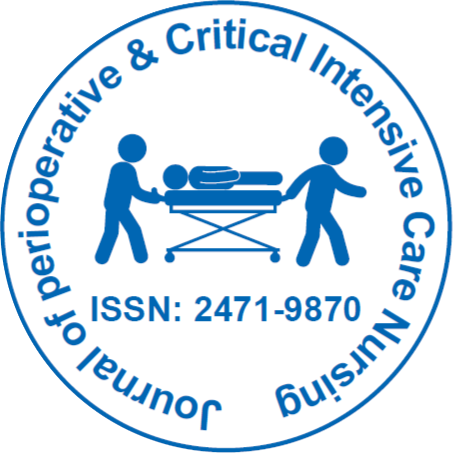
Journal of Perioperative & Critical Intensive Care Nursing
Open Access
ISSN: 2471-9870

ISSN: 2471-9870
Commentary - (2024)Volume 10, Issue 3
Infection control in the Intensive Care Unit (ICU) is an important component of patient safety and quality of care. ICUs are environments where patients are often vulnerable due to severe illness, invasive procedures and the presence of multiple healthcare providers. Consequently, the risk of Healthcare- Associated Infections (HAIs) is significantly elevated. This article discusses about the principles of infection control in the ICU, emphasizing strategies that protect both patients and healthcare workers. By implementing these measures, ICUs can effectively reduce the incidence of HAIs and promote a safer care environment
Importance of infection control
The ICU is a high-risk area for infections due to various factors, including the use of invasive devices like ventilators, central lines and catheters. These devices can serve as entry points for pathogens, making it essential to implement stringent infection control measures. The consequences of HAIs in the ICU can be severe, leading to prolonged hospital stays, increased healthcare costs and higher mortality rates. Therefore, effective infection control is paramount for improving patient outcomes and ensuring a safe environment for both patients and staff.
Key infection control practices
Effective infection control practices are essential in healthcare settings to prevent the spread of infections. Here are some key practices:
Hand hygiene: Hand hygiene is the foundation of infection control in any healthcare setting and its importance is magnified in the ICU. Healthcare workers must adhere to strict hand hygiene protocols, including washing hands with soap and water or using alcohol-based hand sanitizers before and after patient contact, handling invasive devices and performing any procedures. Regular training and monitoring can help reinforce compliance and foster a culture of safety within the ICU.
Use of Personal Protective Equipment (PPE): Personal protective equipment is vital for preventing the transmission of infections between patients and healthcare workers. In the ICU, staff should utilize appropriate PPE, including gloves, gowns, masks and eye protection, especially when dealing with potentially infectious materials. The correct use of PPE not only protects healthcare workers but also minimizes the risk of crosscontamination among patients.
Environmental cleaning and disinfection: Maintaining a clean and disinfected environment is important for infection control in the ICU. Regular cleaning of surfaces, equipment and hightouch areas must be conducted using appropriate disinfectants. The frequency of cleaning should be increased during outbreaks or when dealing with known infectious agents. Furthermore, the use of disposable or single-use equipment wherever possible can reduce the risk of environmental contamination.
Infection surveillance: Implementing robust infection surveillance systems is essential for identifying infection trends and outbreaks within the ICU. Surveillance can help healthcare teams monitor the incidence of HAIs and assess the effectiveness of current infection control practices. This data-driven approach allows for timely interventions, tailored protocols and continuous improvement in infection prevention efforts. Moreover, engaging the entire healthcare team in surveillance initiatives promotes accountability and enhances communication regarding infection control issues.
Multidisciplinary approach
Infection control in the ICU requires a collaborative effort from all healthcare team members, including physicians, nurses, infection control practitioners and environmental services staff. Regular multidisciplinary meetings can facilitate open communication, share best practices and address challenges related to infection control. By fostering a team-oriented approach, the ICU can enhance its ability to prevent infections and improve patient safety. Additionally, ongoing education and training for all team members on infection prevention protocols are important. This collective commitment not only strengthens compliance but also builds a culture of safety within the ICU.
Education and training
Continuous education and training are vital components of effective infection control strategies. Healthcare workers should receive ongoing training on infection prevention protocols, new technologies and emerging pathogens. Simulation-based training can be particularly effective in preparing staff for real-life scenarios, ensuring they are equipped to handle infection control challenges confidently.
Infection control in the ICU is a multifaceted endeavor that demands vigilance, teamwork and adherence to best practices.
By prioritizing hand hygiene, utilizing PPE, maintaining a clean environment and implementing robust surveillance systems, healthcare teams can significantly reduce the risk of HAIs and improve patient outcomes. As the landscape of healthcare continues to evolve, a steadfast commitment to infection control will remain essential for safeguarding the health and safety of patients and healthcare workers alike.
Citation: Fiely N (2024). Interdisciplinary Strategies for ICU Protection of Patients. J Perioper Crit Intensive Care Nurs.10:256.
Received: 26-Aug-2024, Manuscript No. JPCIC-24-34550 ; Editor assigned: 28-Aug-2024, Pre QC No. JPCIC-24-34550 (PQ); Reviewed: 11-Sep-2024, QC No. JPCIC-24-34550 ; Revised: 18-Sep-2024, Manuscript No. JPCIC-24-34550 (R); Published: 25-Sep-2024 , DOI: 10.35248/2471-9870.24.10.256
Copyright: © 2024 Fiely N. This is an open-access article distributed under the terms of the Creative Commons Attribution License, which permits unrestricted use, distribution, and reproduction in any medium, provided the original author and source are credited.